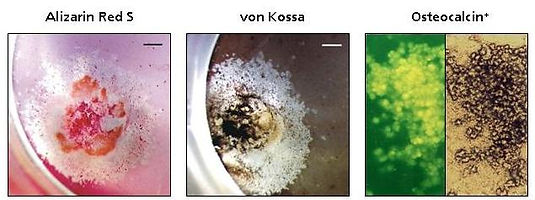zur Nieden Research Group at UC Riverside
Our Research
The pluripotent potential of embryonic stem cells (ESCs) is frequently exploited to study organogenesis in vitro. The lab has previously carried out critical research in the mouse model concentrating on expansion and differentiation of ESCs and identification of essential regulatory pathways. We have established protocols for the in vitro differentiation of murine ESCs into mineralized osteoblasts (Fig. 1) and matrix-secreting chondrocytes. Not only did these analyses reveal the fact that functioning skeletal cell types had been generated from ESCs, but also resulted in a comprehensive analysis of the expression of bone marker genes and osteo-specific enzymatic activity. From these analyses we hypothesize that osteogenesis in ESCs traverses through at least four distinct phases: proliferation (I), early osteogenic specification (II), matrix deposition (III) and mineralization (IV).

Fig. 1: Osteoblasts differentiated from murine ESCs. Differentiation was induced with beta-glycerophosphate, ascorbic acid and 1,25-OH2 vitamin D3 from culture day 5 to 30 [zur Nieden et al., 2003]. (Left) Alizarin Red S and (Middle) von Kossa stain for mineralized calcium. Bars = 160 µm. (Right) Osteocalcin immuno-positive cells (left panel) appear black in phase contrast (right panel).
Using the ESC model, a major goal of our research group is a) to embark on deepening the knowledge of stem cell specification into osteogenic lineages, b) to understand molecular regulators of normal bone development and thereby c) to deduce novel therapeutic targets, which could be aimed at during disease intervention in the clinic.
Current Research Interests

Fig. 2: Regulation of ESC differentiation through CatnB. Activation or blockage of nuclear CatnB activity controls lineage decisions. The duration of the specific signal seems to play a role in the transcriptional activation of lineage-specific transcription factors [Davis and zur Nieden, 2008].
-
Soluble factors influence the Wnt/CatnB pathway during differentiation.
Further work in the lab has shown that nitric oxide (NO) agonists or antagonists may both support osteogenesis in ESCs depending on the timing of their administration. NO donor administration aids mineralization and maturation of the ESCs in late differentiation (phase IV), whereas inhibition of the NO pathway supports specification into an osteoprogenitor state (phase III). Our preliminary studies have shown that a critical phase exists during osteogenesis, in which the addition of NO agonists appears to be necessary for the formation of what would be the equivalent of the primitive streak in vivo, which occurs around day 3 of in vitro differentiation (phase II). Our more extended analyses have shown that NO influences the localization and expression level of beta-catenin (CatnB), a key player in the Wnt signaling pathway. Timely controlled fluctuations in the CatnB level seem to be essential for osteogenic differentiation and maybe even for the specification of other lineages (Fig. 2).
-
Elucidating the role of non-canonical Wnts during differentiation.
While CatnB is the key effector in the canonical Wnt signaling cascade, non-canonical Wnts (i.e. Wnt5a) have been shown to block CatnB activity. Many of the associated proteins of the non-canonical Wnt pathway have been well characterized in an isolated function as they can interact and signal through other developmental pathways. The key components of the three non-canonical pathways so far identified are CamKII, JNK and PKC. As we have established, treatment with Wnt5a during phase III of in vitro development can support the osteogenic differentiation path. We now aim to investigate, which of the three suggested subpathways is involved in the osteogenic process. First data suggests that proliferation of progenitors and the onset of mineralization are modulated by PKCbeta, whereas CamKII seems to modulate cAMP levels and expression of mature bone markers.
-
Oxidative stress modulates the Wnt/CatnB axis.
In contrast to murine ESCs, which can be reasonably well expanded in vitro, primate ESCs tend to differentiate spontaneously in culture. The successful expansion of ESCs therefore might be eased by mimicking the conditions ESCs experience in their natural niche. The lab has begun to explore the role of oxidative stress in ESC maintenance and differentiation. Preliminary results suggest that high glucose levels, which are currently routinely used in ESC culture media, adversely affect stem cell characteristics although supporting proliferation by altering Wnt/CatnB signaling.
-
MicroRNAs regulate the Wnt/CatnB axis during the osteogenic process.
Being signaling molecules, Wnts and NO exert their effects by being translated into intracellular signals ultimately activating the transcriptional machinery. Intriguingly, most of these external factors not only regulate osteogenic processes, but can also be involved in the cellular differentiation into other lineages, such as neurogenesis. Consequently, it is likely that another (master) level of regulation may exist in addition to these external stimuli.
In order to identify such an osteogenic master regulator, the lab also studies microRNAs (miRNAs). These RNA molecules are short 20-22 nucleotide RNA structures that are negative regulators of gene expression in more than 30% of protein-coding genes in a variety of eukaryotic organisms. Additionally, miRNAs seem to be involved in regulating stem cell organization affecting self-renewal, proliferation and differentiation. The lab has so far successfully identified 25 miRNAs, which are differentially regulated during the first 8 days of the osteogenic developmental path. Future studies will characterize the role of these miRNAs in more depth and ultimately lead to the identification of new target molecules, which may be malfunctioning in degenerative and congenital bone diseases.